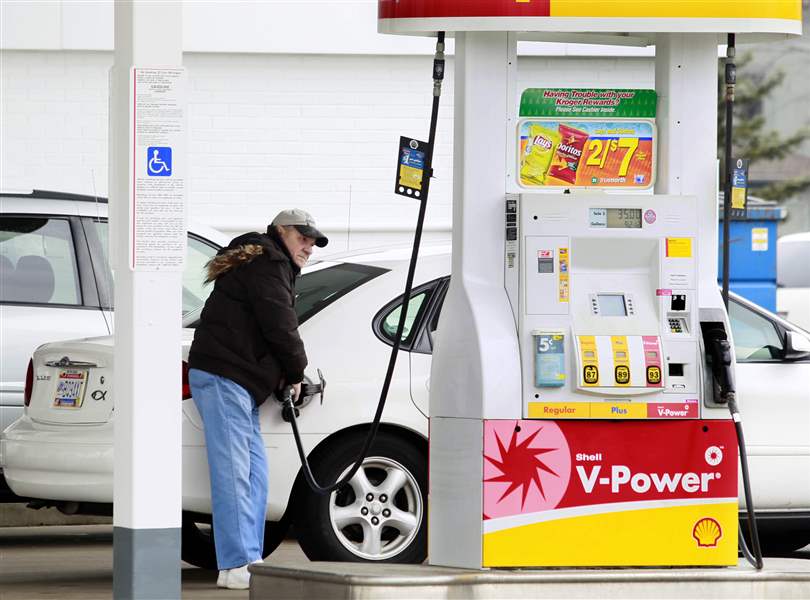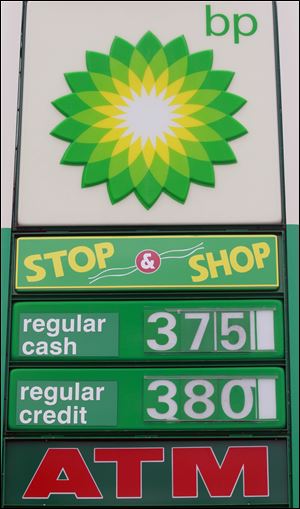
Pain at pump not translating into trade-ins
No rush seen for fuel-efficient, hybrid vehicles
3/4/2012
Chester Hall of Sylvania Township fills up his Ford Taurus at a Shell station on West Central Avenue. Though there's not a rush for smaller cars, dealers and analysts still expect increased demand.
the blade/amy e. voigt
Buy This Image

Chester Hall of Sylvania Township fills up his Ford Taurus at a Shell station on West Central Avenue. Though there's not a rush for smaller cars, dealers and analysts still expect increased demand.
As gas again nudges toward the $4 mark, the nation's drivers have resumed their collective grumble. But this time it seems fewer people are rushing to dump their trucks in favor of fuel-sippers or hybrids.
"We're selling as many pickups as we're selling little cars," said Greg Dunn, general sales manager at Dunn Chevrolet in Oregon. "The last time gas was up over $4 [per gallon] it seemed like people were trading in trucks and getting cars. This time, not that they're immune to it, but they're kind of saying 'Oh well, I've always driven a truck, I'm going to keep driving a truck.' "
Back in July, 2008, when the national average gas price peaked at more than $4.10 per gallon, used car lots were full of trucks and sport utility vehicles and finding a decently priced small car was a chore.
Though analysts still expect increased demand -- and with it, higher prices -- for smaller, more fuel-efficient compact cars and hybrids, Mr. Dunn and other local dealers aren't seeing it yet.
Part of the reason may be a higher threshold for pump pain.
CNW Marketing Research in Bandon, Ore., tracks the price level at which consumers say they would alter their driving and buying habits. In their February survey, that point seemed to be around $4.50 per gallon.
"What we've seen is, if it's a slow rise in gas prices, people are able to make adjustments based on how they drive, and the vehicles they have in the family fleet," said Art Spinella, president of CNW. "Their threshold, their breaking point, has tended to move upward."

Drivers are grumbling as the price of gas edges upward, but analysts wonder if motorists' pump pain is at a higher threshold.
If gas prices stayed at $4.50 for six months, 99 percent of respondents said they'd eventually purchase a more fuel-efficient vehicle, while 87 percent said they'd purchase one immediately. That compares with 83 percent and 73 percent respectively at $4 per gallon. Also at $4.50 a gallon, 93 percent said they'd consider a hybrid. At $4, only 31 percent would consider a hybrid. A majority of respondents also said they'd change their driving habits at $4.50 a gallon.
The survey included people in the market for new cars and was done by both phone calls and mailings.
A year ago, 94 percent of people said they'd eventually buy a more fuel-efficient car at $4 per gallon, while 81 percent they'd buy one immediately. Eighty-two percent reported they'd consider a hybrid at that price.
According to AAA's Daily Fuel Gauge Report, the average per-gallon price for regular gas in Ohio was $3.76 on Friday, up from $3.65 a week ago and $3.45 a month ago. The national average was $3.74.
"I think a lot of people are used to it now, and I think they think it's going to go up and come back down. The first few times, it was making people nervous. It's happened so many times, it's not bothering them," said Denny Amrhein, managing partner at Grogan's Towne Chrysler Dodge Jeep in Toledo.
Mr. Amrhein said his dealership had what was perhaps the best February in its 55-year history, but most buyers were staying in segment.
That is, those trading in an SUV drove off in a new SUV.
Part of the reason for an increased tolerance for high gas prices may be that people are more confident about the economic recovery.
"The fear of the economy started to decline a little bit, and folks started to ramp up purchase of larger vehicles again," said David McClough, an assistant professor of economics at Ohio Northern University in Ada. "There's no question consumers had more of a knee-jerk reaction last time than they did this time."
Sales strong
Still, automakers reported strong sales of new small cars in February. General Motors Co. said sales of small and compact cars were up 42 percent from the same month last year. Fiat USA sold the most 500s here in February since the Italian compact's launch last March. Ford Motor Co. doubled sales of its Focus from last year, and Honda sold 42 percent more Civics this year than in 2011.
In the past, small cars often meant small profit margins, especially for the domestics. That's not the case anymore.
Jesse Toprak, vice president of market intelligence for TrueCar.com, said changes made over the past few years have made small vehicles more profitable.
Also a boon: Buyers are loading them up with pricey options, which are big money-makers for car companies.
Mr. Toprak said people who are downsizing don't want to give up the amenities they were used to in their larger cars.
"They end up loading up the small car with a lot of options. One proof of that has been the average transaction price in the industry. Intuitively you'd think in a time of uncertainty and high gas prices, the average transaction price would go down," he said. "In fact, it has reached some of its record highs recently."
According to TrueCar, the average transaction price for new vehicles in each of the last five months has been above $30,000.
Mr. Toprak said February was expected to come in around $30,100 -- the highest ever for the month.
Price gaining
On the used-car side, Kelley Blue Book reported a 2 to 3 percent increase in price for compacts last week and expects to see used cars in that segment gain 4 to 5 percent a month as long as fuel prices remain high.
"We could see gains in excess of 15 to 20 percent in the next few months if gas prices continue to rise and surpass $4," said Alec Gutierrez, a senior market analyst with Kelley Blue Book.
As seasonal demand for gasoline -- and with it, small cars -- typically grows into summer, analysts from both Kelley Blue Book and TrueCar say if someone's set on buying, doing it sooner rather than later might be a good idea.
However, if you're considering buying solely to upgrade your miles per gallon, you might want to pull out a calculator. Unless someone is trading in a full-size SUV for a compact car -- something buyers rarely do -- it may not be worth it.
As an example, Mr. Gutierrez illustrates it this way: If gas prices rise one dollar, a driver getting 20 miles per gallon and driving the typical 12,000 miles per year will only spend about $10 to $11 dollars more a week on gas.
Timing is everything
If you are looking to dump a gas guzzler, doing it at the height of gas prices could be a poor decision.
"You're selling a commodity at the worst possible time," Mr. Toprak said. "You're going to get robbed if you trade it or sell it, and then if you want to buy a small car or small SUV, you're going to pay premium. You're going to lose money on your trade, you're going to pay more for your new vehicle."
Consumer psychology being what it is, some people don't bother to do the figuring or simply don't care that the math doesn't add up.
"A lot of consumers do end up paying much more for the vehicle than they'll ever save in gas, but on the other side of that, a lot of folks are willing to make the up-front payment. The perception is that if they are paying a little less at the pump, they're actually saving every singe time," Mr. McClough said.
Of course, if you need a little push to buy a new car, high gas prices are always a good excuse.
Why keep your old Jeep Wrangler that gets 17 mpg when you can get the shiny new one that gets 21 mpg?
"While that's a major part of it, getting better fuel economy, it's almost secondary," for many buyers, Mr. Spinella said. "The real motivation is that they want to get the new model [and] that winds up being an excuse to get it."
Contact Tyrel Linkhorn at: tlinkhorn@theblade.com or 419-724-6134.